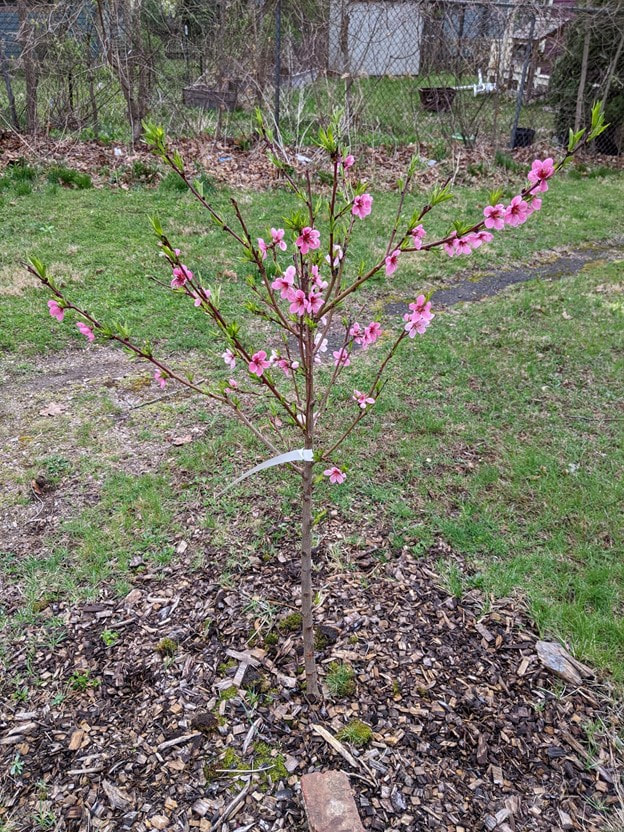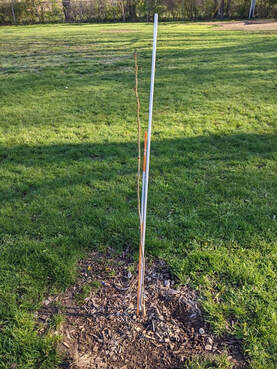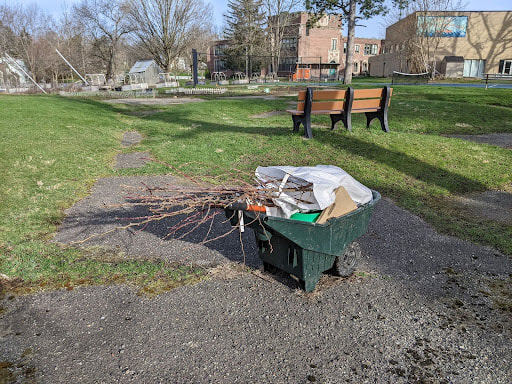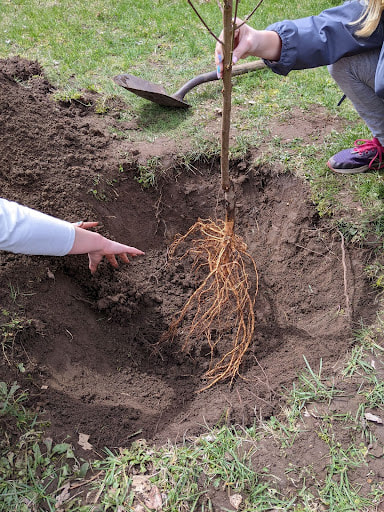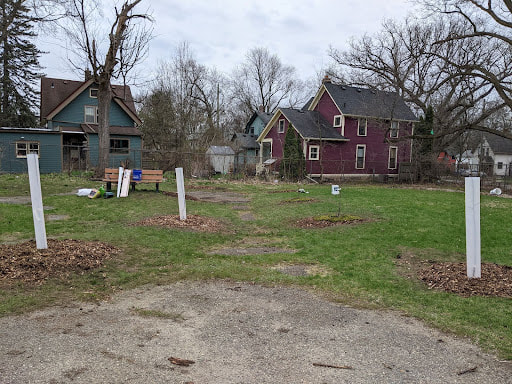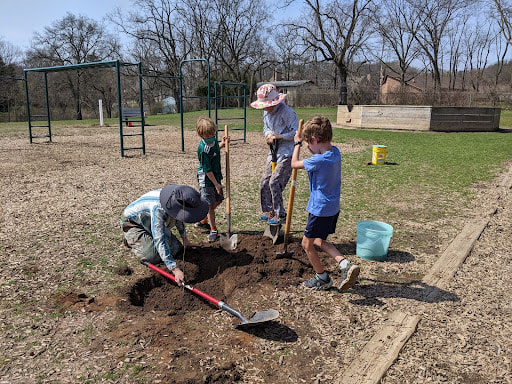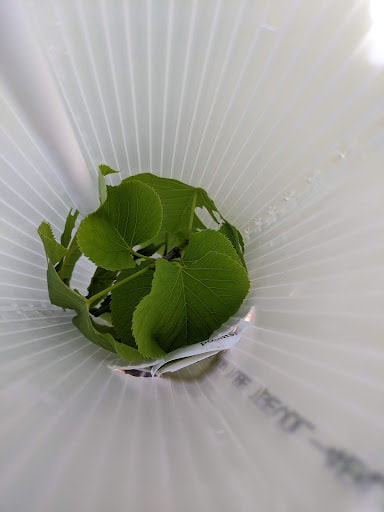2021 WCCD School & Community Habitat Grant Awardee Report:
Ann Arbor Open School
Michigan Native Trees for Education & Play
The Ann Arbor Open School, near the westside of downtown Ann Arbor, submitted an application 2021 School & Community Habitat Grant from a collaboration of school staff and students' families. Two parents led the application, Sam Firke, lead tree volunteer, and Jane Klingsten, garden coordinator, continuing a playground renovation committee's work since 2016. Additional involvement came from Dagney H, parent / master composter / master rain gardener, Maria, a parent, and Aina, the 7-8th grade science teacher, who's organized the garden for 16 years. They presented the goal of introducing more trees to the compact school grounds to introduce more "mini-environments" where students could interact with plants in play and education. Furthermore they outlined the ecological benefits of increasing tree canopy in replacement of turfgrass areas, including adding the habitat for various animal residents, notably a nearby den of foxes.
They were awarded the grant and started working with David M. of PlantWise LLC, who visited and advised on the plantings. The group made a plan for fruit trees with durability in mind, from students and the lawn mowing crews, as well as planting conifers to create a visual / noise screen from the nearby road. While the group was seeking more mature trees, the grant offers tree seedlings through the WCCD annual Tree Distributions, they were able to plant a variety of bare root fruit trees and transplants that have a better chance of surviving and making their vision a reality.
Sam and Jane became regulars among the various WCCD resource distributions. Sam was the likely first and only person ever to ride their bike to pick-up orders at both a tree and rain barrels distribution! Jane supported distributing extra trees to schools, borrowed WCCD planting tools for the school planting days, and supported the distributions by volunteering with her family. It's been a pleasure working with them and the A2Open project.
- Doug Reith, WCCD Resource Coordinator, August 2022
They were awarded the grant and started working with David M. of PlantWise LLC, who visited and advised on the plantings. The group made a plan for fruit trees with durability in mind, from students and the lawn mowing crews, as well as planting conifers to create a visual / noise screen from the nearby road. While the group was seeking more mature trees, the grant offers tree seedlings through the WCCD annual Tree Distributions, they were able to plant a variety of bare root fruit trees and transplants that have a better chance of surviving and making their vision a reality.
Sam and Jane became regulars among the various WCCD resource distributions. Sam was the likely first and only person ever to ride their bike to pick-up orders at both a tree and rain barrels distribution! Jane supported distributing extra trees to schools, borrowed WCCD planting tools for the school planting days, and supported the distributions by volunteering with her family. It's been a pleasure working with them and the A2Open project.
- Doug Reith, WCCD Resource Coordinator, August 2022
|
2023 Michigan Native Trees for Education & Play - 1-Year Update Report
Report written by Sam Firke, Ann Arbor Open School Parent July 2023 One year later, most of our trees are thriving. We planted around three dozen trees as part of the WCCD habitat grant and around 90% survived their first year. Students have been remarkably careful around the trees planted near play areas and on the playground; we think the tree tubes help prevent collisions by making the trees more visible. Some trees are already outgrowing their tubes. |
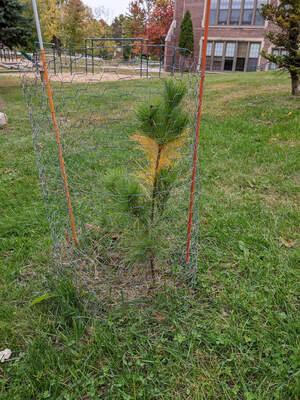
Some trees have survived but needed help. This Sycamore put on height during its first year, but upon inspection at the end of the year, we saw it had taken on a V-shape, with two trunks. For its long-term health we pruned one of them. Hopefully the tree can survive this shock.
The school leadership changed during the first year of this project. Luckily, the grant implementation team was parent-led so was able to persist and onboard the new administration, who have been supportive of the project. As some community members have been unable to keep contributing to the project, others have joined up and stepped in.
The trees are still too young to provide fruit or shade, but they’re already teaching us. We worried when needles on the Eastern White Pines along Miller Rd turned yellow last October. After some reading we learned that White Pines keep needles for only two years.
So if the needles turning yellow and dropping are only inside of the canopy or on the middle of the branches, it's likely typical, healthy behavior. And indeed, all of the yellow needles were on the main trunks!
One unforeseen benefit to the grant: the team that grew around the project has kept sowing native plants in the year since the grant trees were planted. We’ve traded plants with each other, planted new native trees at the school like the hoptree and ninebark, and we replaced the dead grant trees with hickory and chinkapin oak.
The WCCD habitat grant put us on a path toward a more verdant and educational outdoor space. It will be many years before these trees have their full impact on humans and other creatures, but after a good first year they are now more likely to survive all the perils they may face.
The school leadership changed during the first year of this project. Luckily, the grant implementation team was parent-led so was able to persist and onboard the new administration, who have been supportive of the project. As some community members have been unable to keep contributing to the project, others have joined up and stepped in.
The trees are still too young to provide fruit or shade, but they’re already teaching us. We worried when needles on the Eastern White Pines along Miller Rd turned yellow last October. After some reading we learned that White Pines keep needles for only two years.
So if the needles turning yellow and dropping are only inside of the canopy or on the middle of the branches, it's likely typical, healthy behavior. And indeed, all of the yellow needles were on the main trunks!
One unforeseen benefit to the grant: the team that grew around the project has kept sowing native plants in the year since the grant trees were planted. We’ve traded plants with each other, planted new native trees at the school like the hoptree and ninebark, and we replaced the dead grant trees with hickory and chinkapin oak.
The WCCD habitat grant put us on a path toward a more verdant and educational outdoor space. It will be many years before these trees have their full impact on humans and other creatures, but after a good first year they are now more likely to survive all the perils they may face.
2022 Final Project Report
by Sam Firke, A2O Parent
August 2022
Our primary goals were to expose students to a variety of native trees and fruit trees, provide sheltered areas in an unshaded playground and fields, and create a richer ecological habitat around the school for the well-being and enjoyment of human and non-human species.
Installation
We began with a consultation from David Mindell at PlantWise LLC who walked the grounds with us and provided feedback on our initial vision. We then refined our project and sought input from parents, teachers, and community members via our A2OpenOutdoors email list. And we continued to coordinate with the school principal. As the weather warmed, we prepared to plant trees throughout the day on Friday, April 22nd - Earth Day.
by Sam Firke, A2O Parent
August 2022
Our primary goals were to expose students to a variety of native trees and fruit trees, provide sheltered areas in an unshaded playground and fields, and create a richer ecological habitat around the school for the well-being and enjoyment of human and non-human species.
Installation
We began with a consultation from David Mindell at PlantWise LLC who walked the grounds with us and provided feedback on our initial vision. We then refined our project and sought input from parents, teachers, and community members via our A2OpenOutdoors email list. And we continued to coordinate with the school principal. As the weather warmed, we prepared to plant trees throughout the day on Friday, April 22nd - Earth Day.
We offered all teachers the opportunity to have their classes plant trees. Classes ranging from 1st to 8th grades planted a small “fruit forest” of 8 fruit trees and a row of Eastern redbuds. As students dug, they unearthed artifacts like bricks and pottery from when garbage was dumped
on the site a century earlier.
on the site a century earlier.
The next day, Saturday, families and community members planted shade trees on the upper playground at a garden workday. Over the following weeks, other classes jumped on the bandwagon and planted the remaining trees, including more redbud and nut trees on a grassy slope and a row of conifers along Miller Rd. And a kindergarten class planted tiny oak trees that they’d grown from acorns during the school year, taking advantage of the coordinated watering and attention that our grant project provided.
Challenges
We wanted to make the full school community, including neighbors and retired teachers, aware of what was happening. And we tried to include their input and wishes in the process. There are many uses for outdoor space at the school, e.g., kids playing ball sports, a theater group that practices outside, a group interested in rebuilding a labyrinth, etc. We wanted to make sure our trees would complement, not restrict, the many uses of the school grounds. Getting people’s attention and input for this project was a challenge, as there were many other worthy initiatives going on at the school simultaneously.
The planting itself was straightforward and we had many helpers. Watering and associated care was harder. First, there was the physical challenge of watering: we have to reach approximately three dozen trees, many of which are a hundred feet or more from the nearest hose spigot. This is a physically-difficult and time-consuming task. And the most critical stretch for regular watering was the hot summer - which is when few people visit the school. We coordinated a volunteer rotation and solicited signups to cover the summer watering so that the workload would be spread out.
We wanted to make the full school community, including neighbors and retired teachers, aware of what was happening. And we tried to include their input and wishes in the process. There are many uses for outdoor space at the school, e.g., kids playing ball sports, a theater group that practices outside, a group interested in rebuilding a labyrinth, etc. We wanted to make sure our trees would complement, not restrict, the many uses of the school grounds. Getting people’s attention and input for this project was a challenge, as there were many other worthy initiatives going on at the school simultaneously.
The planting itself was straightforward and we had many helpers. Watering and associated care was harder. First, there was the physical challenge of watering: we have to reach approximately three dozen trees, many of which are a hundred feet or more from the nearest hose spigot. This is a physically-difficult and time-consuming task. And the most critical stretch for regular watering was the hot summer - which is when few people visit the school. We coordinated a volunteer rotation and solicited signups to cover the summer watering so that the workload would be spread out.
Plan for the First Year (and beyond)
In addition to watering throughout the year, we’ll need to mulch and weed. Our trees are all planted in grass that gets mowed, so keeping the area around their trunks tidy will reduce the likelihood of incidental damage from a string trimmer.
We’ll monitor for deer browsing damage and fence as needed. The area has relatively light deer presence, more pronounced in winter.
Over time we’ll remove tree tubes when the trees are sufficiently mature and replace those trees that die.
We hope that this grant-supported planting was just the beginning in enriching our natural habitat for the enjoyment of all. In future years, we may introduce other harder-to-source native trees, species that weren’t available from the WCCD tree and shrub sale, notably Shagbark Hickory and Red Oak (our school is on a street called Red Oak so it would be particularly appropriate!).
In addition to watering throughout the year, we’ll need to mulch and weed. Our trees are all planted in grass that gets mowed, so keeping the area around their trunks tidy will reduce the likelihood of incidental damage from a string trimmer.
We’ll monitor for deer browsing damage and fence as needed. The area has relatively light deer presence, more pronounced in winter.
Over time we’ll remove tree tubes when the trees are sufficiently mature and replace those trees that die.
We hope that this grant-supported planting was just the beginning in enriching our natural habitat for the enjoyment of all. In future years, we may introduce other harder-to-source native trees, species that weren’t available from the WCCD tree and shrub sale, notably Shagbark Hickory and Red Oak (our school is on a street called Red Oak so it would be particularly appropriate!).





